In the dynamic world of the agriculture drone business, staying ahead means not just embracing technology but mastering it. “Soaring Profits: How to Launch a Successful Agriculture Drone Business in 2024” offers an extensive guide tailored for the UK’s burgeoning drone sector, from selecting the right drone and understanding its maintenance to navigating the complex web of regulations and unlocking the potential of data analysis. Whether you’re a seasoned farmer looking to modernize your operations or an entrepreneur at the forefront of agricultural innovation, this blog post provides the insights and practical advice you need to elevate your agricultural practices to new heights. Join us as we explore the key components of integrating drones into agriculture, ensuring you’re well-equipped to reap the benefits of this transformative technology.
Table of Contents
Types of Drones Used in Agriculture
The agriculture drone business is revolutionizing farming practices across the UK, offering innovative solutions to age-old challenges. Drones, or Unmanned Aerial Vehicles (UAVs), are at the forefront of this transformation, providing data-driven insights for optimized crop management, soil health, and resource allocation. Understanding the types of drones utilized can empower farmers and agricultural entrepreneurs to make informed decisions for their operations. Here, we delve into the primary drones used in agriculture, highlighting their unique capabilities and where they fit into modern farming practices.
Fixed-Wing Drones
Fixed-wing drones resemble traditional airplanes in design, with a single rigid wing that provides lift as they move forward. Their streamlined shape allows for longer flight times and the ability to cover vast areas of land efficiently, making them ideal for large-scale crop monitoring and mapping. AG Eagle look like they are leading in this market.
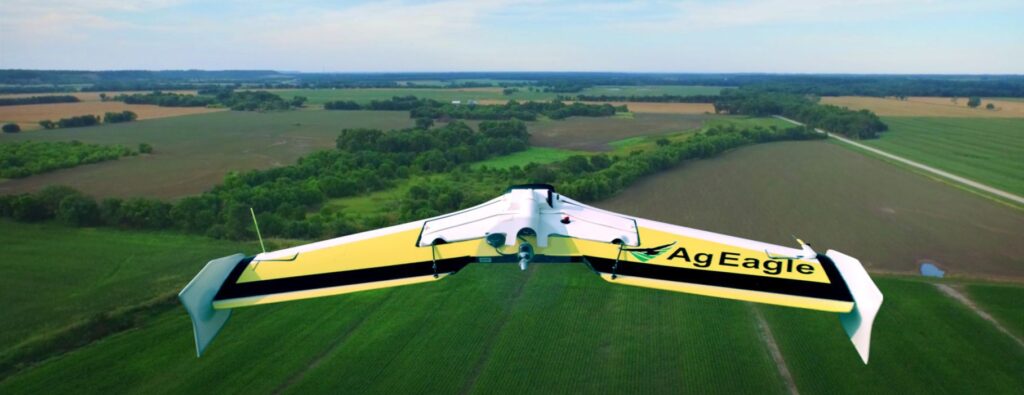
Rotary-Wing Drones
Rotary-wing drones, including quadcopters, are characterized by their multiple rotors which enable vertical takeoff and landing (VTOL). This capability allows them to hover in place, maneuver through tight spaces, and operate effectively in smaller fields or areas requiring detailed observation, such as individual tree or plant inspections.
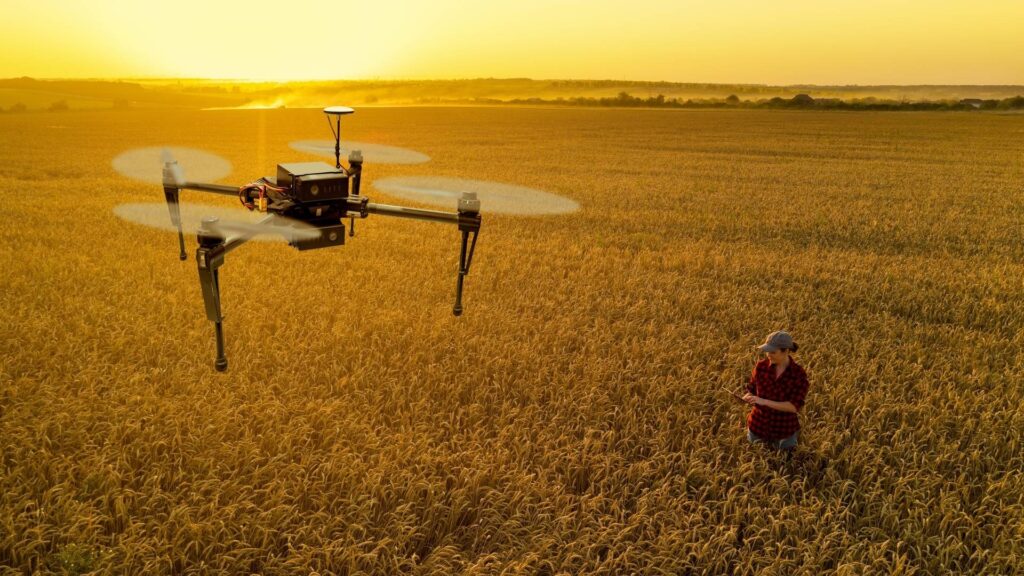
Hybrid Drones
Hybrid drones combine elements of both fixed and rotary-wing designs, offering the endurance and speed of fixed-wing UAVs with the VTOL capabilities of rotary-wing models. This versatility makes them suitable for a wide range of agricultural applications, from precision spraying to detailed crop and livestock monitoring.
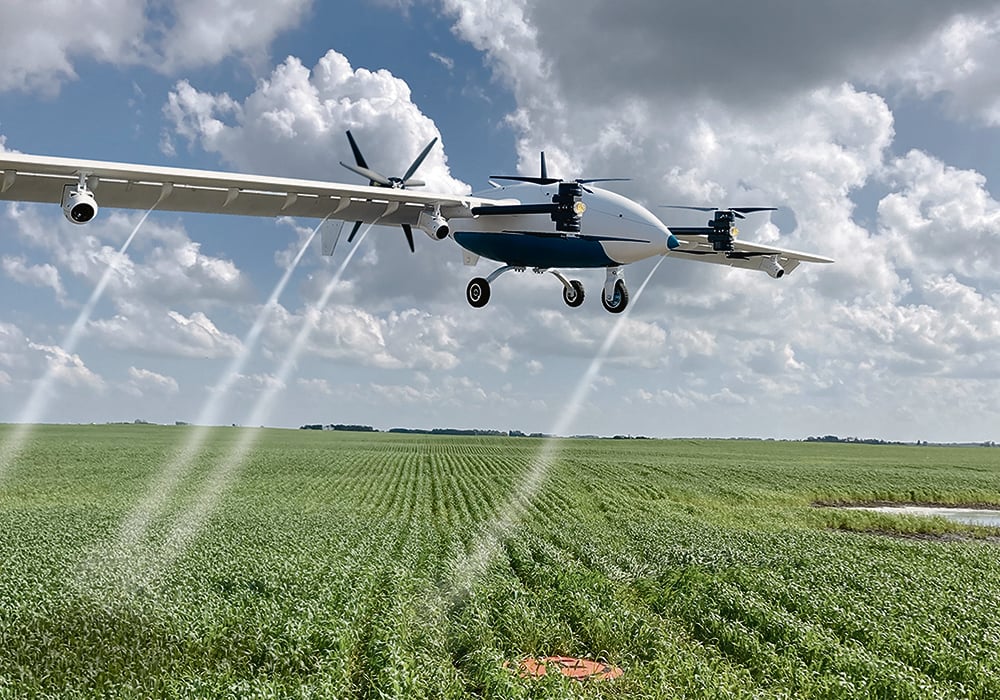
Multi-Spectral Imaging Drones
While not a separate category based on flight mechanics, drones equipped with multi-spectral imaging cameras deserve mention for their profound impact on agriculture. These UAVs capture data beyond the visible spectrum, offering insights into plant health, moisture levels, and pest stress invisible to the naked eye. Multi-spectral drones are invaluable for precision agriculture, allowing for targeted interventions that save time and resources.

Choosing the Right Drone for Your Agriculture Business
Selecting the appropriate drone type for your agriculture business in 2024 hinges on understanding your specific operational needs. Fixed-wing drones are best suited for expansive acreages, providing a broad overview of crop conditions. Rotary-wing and hybrid drones excel in precision tasks and varied terrain, offering flexibility and detailed data collection. For advanced agricultural insights, investing in drones with specialized imaging capabilities can unlock new levels of crop management efficiency.
In the rapidly evolving landscape of UK agriculture, drones are not just tools but pivotal assets in achieving sustainable, profitable farming practices. As technology advances, the potential applications of drones in agriculture will continue to expand, driving innovation and productivity in the sector.
Soaring Profits: How to Launch a Successful Agriculture Drone Business in 2024 aims to guide you through these technological advancements, ensuring your venture not only takes off but reaches unprecedented heights in the modern farming era.
Key Features to Look For in Agriculture Drones
When venturing into the agriculture drone business in the UK, selecting the right UAV (Unmanned Aerial Vehicle) can significantly influence operational success and efficiency. With a diverse range of drones on the market, understanding the key features to look for can guide you in making an informed decision. This segment outlines essential aspects that are pivotal for optimizing agricultural practices through drone technology.
Flight Time and Battery Life
Flight time and battery life are crucial for conducting comprehensive surveys of farmlands without frequent interruptions for recharging. Longer flight times enable coverage of extensive areas in a single flight, making drones more efficient for large-scale operations.
Camera Quality and Imaging Capabilities
High-quality cameras and advanced imaging capabilities are essential for capturing detailed aerial photographs and videos. Look for drones equipped with multi-spectral or thermal imaging cameras that can provide vital data on crop health, irrigation needs, and pest detection.
Durability and Weather Resistance
The UK’s varied climate demands durable and weather-resistant drones capable of operating in different environmental conditions. Drones that can withstand wind, rain, and temperature variations are indispensable for year-round agricultural monitoring.
Range and Connectivity
Range and connectivity determine how far a drone can travel from the controller while maintaining a stable connection. A longer range is beneficial for covering vast tracts of land, while robust connectivity ensures real-time data transmission and control.
User-Friendly Interface and Software Integration
A user-friendly interface and seamless software integration allow for efficient data analysis and interpretation. Drones that come with or are compatible with agricultural management software can streamline workflow, from data collection to actionable insights.
Precision and Stability
For tasks such as crop spraying or targeted inspections, precision and stability in flight are non-negotiable. Drones with stable hovering capabilities and precise navigation systems can ensure accurate application and data collection, minimizing waste and maximizing results.
After-Sales Support and Maintenance Services
Reliable after-sales support and maintenance services are essential for the longevity of your investment. Ensure that your drone supplier offers comprehensive support, including spare parts availability, technical assistance, and repair services.
In the rapidly growing agriculture drone business, choosing a drone with the right mix of features can be the difference between success and struggle. As you explore the possibilities drones bring to UK agriculture, prioritizing these key features will ensure you select a UAV that not only meets your current needs but also adapts to future advancements in farming technology.
Benefits of Using Drones in Agriculture
The agriculture drone business is soaring in the UK, with farmers and agricultural professionals increasingly recognizing the myriad benefits these advanced tools bring to the field. From enhanced crop monitoring to precision farming practices, drones are revolutionizing the way agriculture operates, offering efficiencies and insights previously unattainable. Here, we explore the key advantages of incorporating drones into farming practices.
Improved Crop Monitoring and Health Assessment
One of the most significant benefits of using drones in agriculture is the ability to monitor crop health swiftly and accurately. High-resolution cameras and specialized sensors can detect issues like pest infestations, fungal infections, and nutrient deficiencies well before they become visible to the naked eye
Precision Agriculture Practices
Drones facilitate precision agriculture by providing detailed data that supports the efficient use of resources, such as water, fertilizers, and pesticides. By targeting only the areas that need attention, farmers can reduce waste, lower costs, and minimize environmental impact.
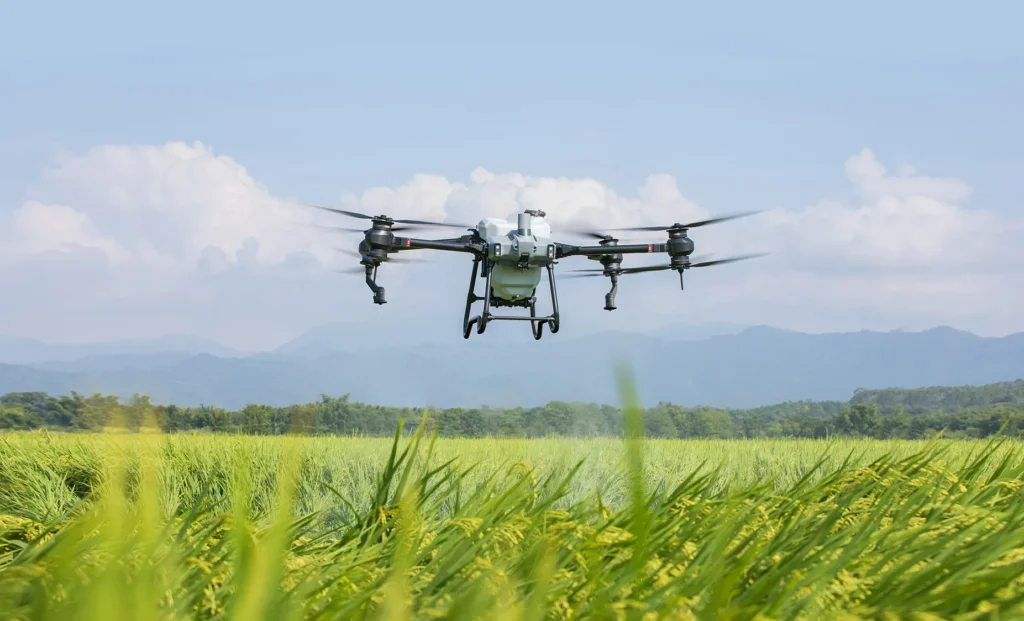
Enhanced Irrigation Management
With the capability to map out the moisture levels across a field, drones play a crucial role in optimizing irrigation practices. Identifying dry areas ensures water is distributed more evenly and efficiently, leading to better crop yields and water conservation.
Time and Cost Efficiency
The use of drones significantly reduces the time and manpower required for tasks such as crop surveys and field inspections. What once took days to complete can now be achieved in a matter of hours, freeing up resources for other critical activities.
Access to Hard-to-Reach Areas
Drones effortlessly navigate over rough terrain or areas that are difficult to access by foot or with ground machinery. This capability ensures that no part of the field goes unchecked, providing a complete overview of the agricultural operation.
Data-Driven Decision Making
The rich data collected by drones, from imagery to sensor readings, empowers farmers with actionable insights for informed decision-making. This data-driven approach to farming enhances operational efficiency, crop yield, and overall farm management.
In conclusion, integrating drones into agricultural practices offers a host of benefits that can lead to more sustainable, efficient, and productive farming operations in the UK. As the agriculture drone business continues to evolve, staying informed about these advantages and how to leverage them will be key for those looking to thrive in the modern agricultural landscape.
Applications of Agriculture Drones
The integration of drones into UK agriculture has opened up a plethora of applications that are transforming farming practices. These unmanned aerial vehicles are not just about capturing aerial photographs—they’re powerful tools for data collection, analysis, and action that drive efficiency, yield, and sustainability in farming operations. Here’s a closer look at the key applications of agriculture drones.
Crop Monitoring and Mapping
Drones offer an unprecedented view of crops across large and small-scale farms, enabling continuous monitoring of plant health, growth, and variations within fields. This aerial perspective is crucial for identifying issues early and making informed decisions.
Soil and Field Analysis
Before planting, drones can be used to create detailed 3D maps of the soil, revealing patterns that indicate moisture levels, texture, and nutrient presence. This information helps in planning the seed planting patterns and optimizing irrigation systems.
Precision Crop Spraying
With drones, farmers can precisely target areas that need pest control or fertilization, significantly reducing the amount of chemicals used. This not only saves costs but also minimizes environmental impact.
Planting
Some drones are equipped to carry seed pods, enabling them to plant seeds in designated areas quickly and efficiently. This method has been shown to increase uptake rates while reducing labor costs.
Livestock Monitoring
Agriculture drones also find their application in monitoring livestock. They can quickly locate animals, monitor their health and behavior, and even keep track of grazing patterns, ensuring the well-being of the livestock and optimizing pasture management.
Irrigation Assistance
Drones equipped with thermal sensors can identify areas of a field experiencing drought or excessive moisture. Farmers can then adjust their irrigation systems to address these specific needs, ensuring optimal water use.
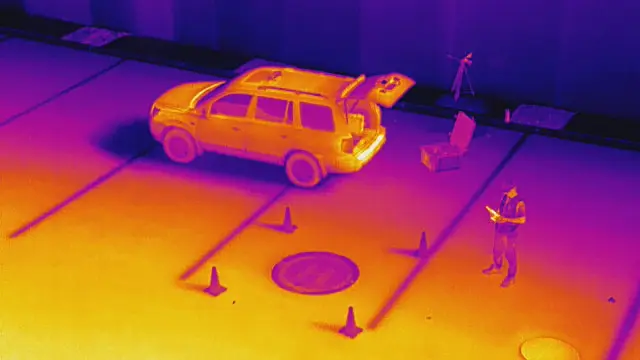
Crop Health Assessment
Using multispectral imaging, drones can assess plant health by capturing data on light absorption and reflection. This allows for the detection of diseases, pests, and nutrient deficiencies before they spread or become more serious.
The adoption of drones in UK agriculture is not just a testament to technological advancement but a move towards more data-driven, efficient, and environmentally friendly farming practices. As the agriculture drone business continues to grow, the potential applications of these versatile machines are bound to expand, offering even more opportunities to enhance agricultural productivity and sustainability.
Regulatory Considerations for Agriculture Drone Business in the UK
Navigating the regulatory landscape is crucial for anyone looking to enter or operate within the agriculture drone business in the UK. Understanding and adhering to these regulations not only ensures legal compliance but also promotes safety and privacy. Here’s an overview of key regulatory considerations.
Drone Registration and Pilot Certification
In the UK, the Civil Aviation Authority (CAA) mandates that drone operators and pilots must register themselves and pass an online education package if their drones weigh between 250 grams and 20 kilograms. This is to ensure that drone pilots are familiar with UK airspace regulations and safety practices.
Specific Category Operations and Risk Assessment
For commercial use, including agriculture, drones typically fall under the Specific category of the CAA’s regulations. Operating in this category requires conducting a detailed risk assessment and obtaining an Operational Authorisation from the CAA, tailored to the specific needs and risks of the operation.
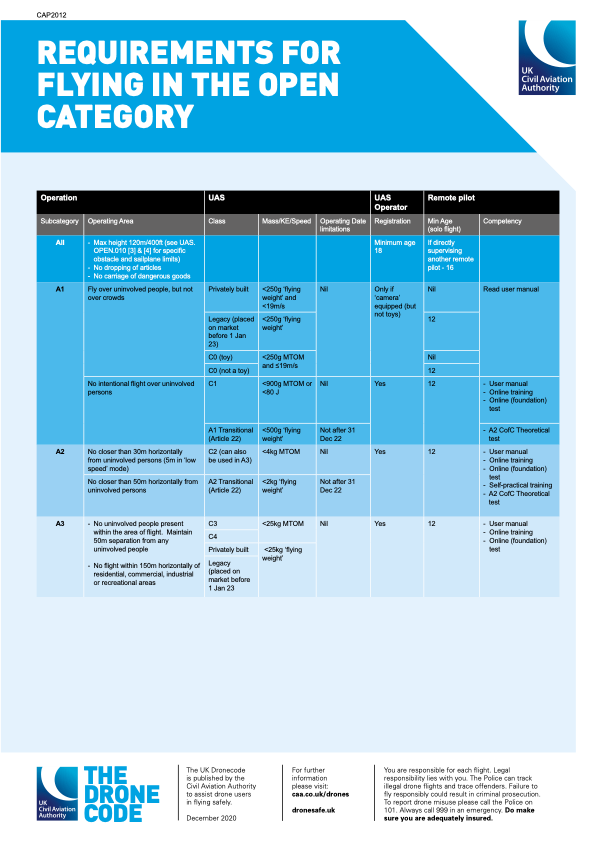
Privacy and Data Protection
When using drones for agricultural purposes, it’s essential to consider privacy laws and data protection regulations, particularly if capturing images or videos that could include individuals or private property. The UK’s General Data Protection Regulation (GDPR) and the Data Protection Act 2018 outline requirements for collecting, storing, and using personal data.
Insurance Requirements
Commercial drone operations in the UK are required to have adequate insurance coverage, in line with Regulation (EC) No 785/2004. This insurance should cover potential liabilities in case of accidents or damage caused by drone activities.
Flying Near Airports and Restricted Airspace
Strict rules govern drone flights in proximity to airports and in restricted airspace. It’s vital to consult and adhere to the Dronecode, a set of guidelines provided by the CAA, which includes restrictions on flying at certain heights and distances from airports.
Understanding these regulatory considerations is fundamental for operating a successful agriculture drone business in the UK. Staying informed about current laws and regulations, and ensuring compliance, will safeguard your operations, protect privacy and public safety, and contribute to the positive growth of the agricultural drone industry.
For the most current information and detailed guidance, always refer to the Civil Aviation Authority’s official website and resources.
Cost Analysis and ROI of Agriculture Drones in the UK
When considering the adoption of drones within the agriculture sector, it’s crucial to understand the financial implications and the potential return on investment (ROI) these technologies can offer. This analysis aims to break down the costs associated with deploying agriculture drones and the tangible benefits they can bring to farming operations in the UK.
Initial Investment and Operational Costs
Initial Investment: The upfront cost of agriculture drones can vary significantly based on the type, capabilities, and specific applications they are designed for. Basic models suitable for small-scale operations may start from a few hundred pounds, whereas advanced drones equipped with sophisticated imaging and data analysis capabilities can cost several thousand pounds.
Operational Costs: Beyond the purchase price, operational costs include maintenance, software subscriptions for data analysis, training for personnel, and potentially insurance. Regular maintenance ensures the drone’s longevity and optimal performance, while software subscriptions are vital for data processing and interpretation.
Potential Savings and Efficiencies
Reduced Labor Costs: Drones can survey large areas of farmland quickly and efficiently, reducing the need for manual labor for tasks like crop monitoring, mapping, and spraying.
Precision Farming: By enabling precision agriculture practices, drones help in the targeted application of inputs (water, fertilizers, pesticides), which can lead to significant savings on these resources.
Increased Crop Yields: Early detection of issues such as pest infestations or disease allows for timely intervention, potentially increasing crop yields and quality.
Calculating Return on Investment (ROI)
To determine the ROI of integrating drones into farming practices, it’s essential to compare the total cost of drone technology (initial investment plus operational costs) against the financial benefits realized (savings and additional revenue from increased yields).
ROI Formula: ���=Total Benefits−Total CostsTotal Costs×100ROI=Total CostsTotal Benefits−Total Costs×100
Using case studies and real-world examples can provide concrete evidence of how drones have impacted farm profitability in the UK.
Long-term Considerations and Sustainability
Investing in drone technology is not just about immediate financial returns; it also concerns the long-term sustainability and competitiveness of farming operations. Drones contribute to more sustainable farming practices by optimizing resource use and reducing environmental impact, which can be pivotal in securing the future of agriculture in the UK.
In conclusion, while the upfront costs of agriculture drones can be significant, the efficiencies, savings, and potential yield improvements they offer can lead to substantial ROI for UK farmers. Careful consideration of the types of drones, their applications, and the specific needs of the farming operation can help maximize the benefits of this innovative technology.
Challenges and Limitations of Agriculture Drones in the UK
While the agriculture drone business offers numerous benefits and opportunities for innovation within UK farming, there are also challenges and limitations to consider. Understanding these hurdles is essential for farmers and agribusinesses looking to integrate drone technology into their operations effectively.
Regulatory Compliance
Regulatory compliance is a significant challenge for drone operators in the agriculture sector. The UK’s Civil Aviation Authority (CAA) has set out specific regulations that govern the use of drones, including where they can fly, how high, and the qualifications required to operate them. Staying abreast of these regulations and ensuring compliance can be complex and time-consuming.

Weather Dependence
Weather dependence is another challenge, particularly in the UK, where unpredictable weather can limit the days drones can be operated effectively. High winds, rain, and poor visibility can all impact a drone’s ability to collect accurate data, affecting the overall utility of the technology.
Technical Limitations and Equipment Costs
Technical limitations and equipment costs can also pose challenges. The most advanced drones, capable of carrying sophisticated sensors and cameras for detailed data collection, come with a high price tag. Additionally, these drones may require regular maintenance and upgrades, adding to the operational costs.
Data Overload and Analysis
Data overload and analysis can be overwhelming for farmers not versed in data science. Agriculture drones generate vast amounts of data, and extracting actionable insights from this information requires specialized software and analytical skills.
Training and Skill Requirements
Training and skill requirements are crucial for safe and effective drone operation. Pilots must understand not only how to fly the drones but also how to maintain them and interpret the data they collect. This necessitates ongoing education and training, which can be a barrier for some farmers.
Integration with Farming Practices
Finally, integration with existing farming practices can be a challenge. Adopting drone technology requires changes in workflow and the adoption of new practices. This transition can be difficult for established farming operations and may require a period of adjustment.
Despite these challenges, the potential benefits of using drones in agriculture — from increased efficiency and productivity to enhanced crop health monitoring — make overcoming these hurdles worthwhile. With the right approach, including staying informed about regulations, investing in training, and choosing the right technology, UK farmers can harness the power of drones to propel their businesses forward in the modern agricultural landscape.
Software and Data Analysis in the Agriculture Drone Business
In the UK, the agriculture drone business has become an integral part of modern farming, enabling more efficient crop management through advanced data analysis. The software that processes and analyzes the data collected by drones is just as crucial as the UAVs themselves. This segment explores the pivotal role of software and data analysis in transforming agricultural practices, ensuring that farmers can make informed decisions to enhance productivity and sustainability.
Choosing the Right Software for Your Needs
Choosing the right software is essential for translating raw data collected by drones into actionable insights. This software varies widely in complexity and specialization, with some focusing on crop health analysis through NDVI (Normalized Difference Vegetation Index) imagery, while others specialize in mapping and field surveying.
Data Processing and Analysis
Data processing and analysis involve converting the raw imagery and sensor data collected by drones into a format that’s easily interpretable by farmers. This process includes stitching together images, analyzing spectral data to assess plant health, and using machine learning algorithms to identify patterns and anomalies.
Real-time Data for Immediate Action
The capability for real-time data analysis represents a significant advancement in agriculture drone software. This feature allows farmers to take immediate action based on the latest information, such as adjusting irrigation systems or applying treatments to areas showing signs of stress or disease.
Integration with Farm Management Systems
Integration with farm management systems is another critical aspect, as it ensures that the insights gained from drone data are seamlessly incorporated into the broader farm operation. This integration facilitates data-driven decision-making across all areas of the farm, from planting and irrigation to harvesting.
Challenges in Data Analysis
Despite the advancements, challenges in data analysis remain, including the need for significant computing power for processing large datasets and the skills required to interpret complex data accurately. Addressing these challenges through continuous software improvement and training is vital for maximizing the benefits of drone technology in agriculture.
In conclusion, the software and data analysis capabilities are at the heart of the agriculture drone business, transforming how UK farmers monitor, manage, and optimize their crops. By selecting the right software, understanding the data analysis process, and integrating insights into daily operations, farmers can leverage drone technology to its fullest potential, ensuring a more productive and sustainable future for agriculture.
Training and Education in the Agriculture Drone Business
The rise of the agriculture drone business in the UK underscores the need for specialized training and education. For farmers and agricultural professionals looking to integrate drone technology into their operations, understanding both the practical and regulatory aspects is crucial. This segment explores the essential training and education pathways that facilitate the effective and compliant use of drones in agriculture.
Understanding Drone Regulations
Understanding drone regulations is the foundational step for anyone entering the agriculture drone sector. In the UK, the Civil Aviation Authority (CAA) outlines specific guidelines and requirements for drone operations, which include registration, pilot certification, and adherence to flight restrictions.
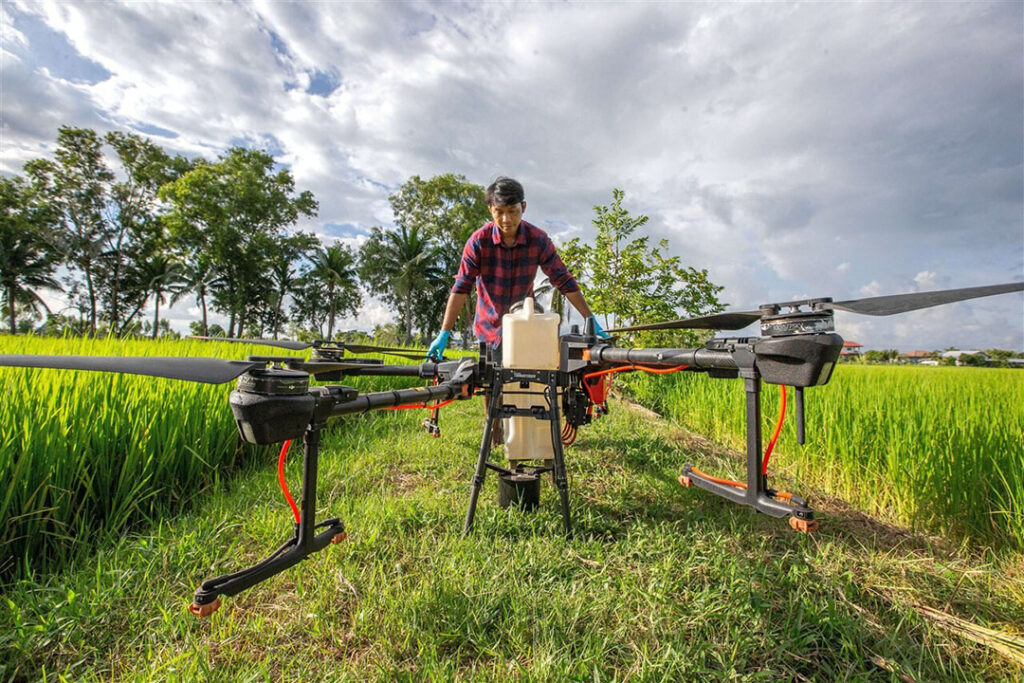
Pilot Training and Certification
Pilot training and certification are critical to ensure safe and effective drone operation. Training courses typically cover a range of topics, from basic flight controls and safety protocols to more advanced subjects like aerial surveying techniques and data analysis.
Specialized Agricultural Drone Courses
Specialized agricultural drone courses focus on the specific applications of drones in farming and agriculture. These may include precision agriculture practices, crop monitoring techniques, and the use of specialized sensors and software for data analysis.
Continuous Professional Development
Continuous professional development is vital in a rapidly evolving field like drone technology. Staying updated with the latest advancements, regulatory changes, and best practices through workshops, seminars, and online resources is crucial for long-term success.
Online Resources and Communities
Online resources and communities serve as invaluable tools for self-learning and networking. Forums, webinars, and online platforms offer a platform for drone enthusiasts and professionals to share experiences, advice, and the latest industry news.
Training and education are indispensable components of the agriculture drone business, providing the knowledge and skills necessary to harness the full potential of drone technology in farming. By investing in comprehensive training and staying engaged with the broader community, UK farmers and agricultural professionals can navigate the complexities of drone operations, ensuring both compliance and efficiency in their agricultural practices.
Emerging Technologies in Agriculture Drones
The agriculture drone business in the UK is at the forefront of integrating cutting-edge technologies to enhance farming practices. As we move further into the 21st century, several emerging technologies are set to revolutionize how drones are used in agriculture, offering unprecedented levels of precision, efficiency, and data analysis capabilities. Here’s a look at some of the most promising advancements.
AI and Machine Learning
AI and Machine Learning are transforming agriculture drones by enabling advanced data analysis and decision-making processes. These technologies allow drones to identify patterns in crop growth, detect pest infestations, and even predict future crop yields with high accuracy.
Hyper-Spectral Imaging
Hyper-Spectral Imaging technology captures a broader spectrum of light than the human eye can see, providing detailed information about crop health, soil fertility, and water saturation levels. This technology can detect minute changes in plants, signaling early warnings of disease or stress.
Autonomous Drones
Autonomous Drones represent a significant leap forward, with the ability to operate independently of human control. Programmed to carry out specific tasks such as seeding, spraying, or systematic field scanning, these drones can improve operational efficiencies and reduce labor costs.
Drone Swarming Technology
Drone Swarming Technology allows multiple drones to operate in sync, covering large areas more quickly and thoroughly than a single drone could achieve. This collective operation is particularly useful for planting seeds, monitoring large-scale crop health, and even herding livestock.
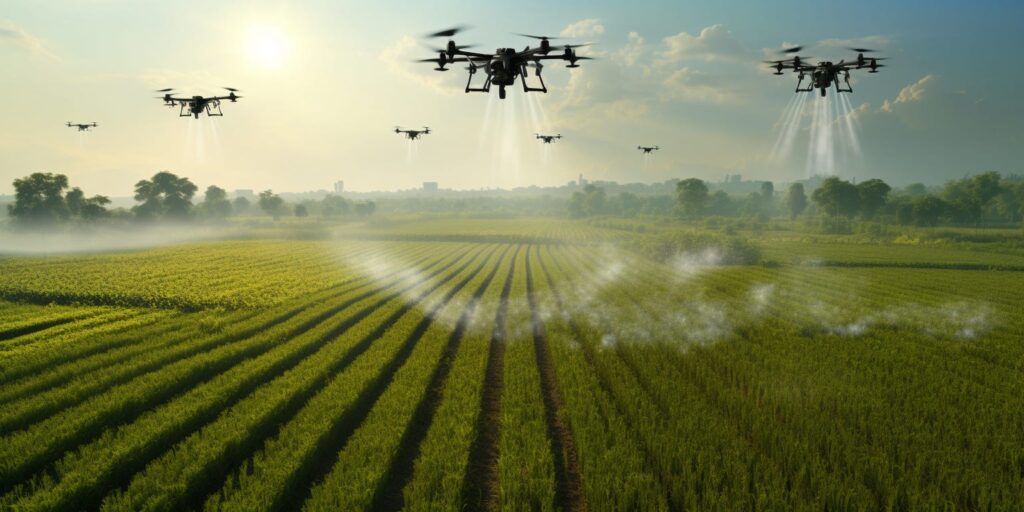
Blockchain for Traceability
Blockchain Technology is starting to play a role in the agriculture drone business by offering a secure and transparent way to track crop production from seed to store. This traceability is crucial for certifying organic products and ensuring the authenticity of farm produce.
As these emerging technologies continue to develop, the potential for innovation within the UK’s agriculture drone business is boundless. With advancements in AI, imaging, autonomy, and beyond, drones are set to become an even more indispensable tool in the farmer’s arsenal, driving sustainability, efficiency, and productivity in agriculture to new heights.
Case Studies in the Agriculture Drone Business
Exploring real-world applications and successes of drone technology in UK agriculture provides valuable insights into the practical benefits and transformative potential of drones in enhancing farming operations. Here are several case studies that illustrate how drones are making a significant impact on the agriculture sector.
Optimizing Crop Yields on a Scottish Farm
Overview: A Scottish farm utilized multispectral imaging drones to monitor crop health across its extensive barley fields. The technology allowed for early detection of nutrient deficiencies and targeted fertilizer application.
Results: The farm reported a noticeable increase in crop yield and quality, attributing the success to precise interventions based on drone data. This case highlights the potential for drones to enhance crop management and boost productivity.
Precision Vineyard Management in England
Overview: A vineyard in Southern England implemented drones equipped with thermal imaging to monitor grapevine health and optimize irrigation. The drones identified areas of stress due to uneven water distribution, enabling precise adjustments to the irrigation system.
Results: The vineyard experienced improved grape quality and a more consistent yield across different sections. This precision approach to irrigation management showcases drones’ utility in specialized crop cultivation.
Livestock Monitoring in Wales
Overview: A livestock farm in Wales adopted drone technology for regular herd monitoring, tracking animal movements, and assessing the health of grasslands. The drones provided a comprehensive overview that was previously unachievable through traditional means.
Results: The farm reported better livestock management, with early detection of health issues and improved grazing patterns. This case underscores drones’ versatility, extending beyond crop farming to effective livestock management.
Sustainable Farming Practices in Northern Ireland
Overview: A Northern Irish farm focused on sustainable practices employed drones to map out and analyze soil health and biodiversity across their fields. The goal was to minimize environmental impact while maintaining productivity.
Results: Drone data supported the implementation of conservation tillage and targeted biodiversity enhancement efforts, leading to a healthier ecosystem without compromising yield. This illustrates drones’ role in promoting environmental sustainability in agriculture.
These case studies from across the UK demonstrate the agriculture drone business’s capacity to address diverse challenges in farming. From increasing crop yields and improving product quality to enhancing sustainable practices and livestock management, drones are proving to be invaluable assets in the modern agricultural landscape.
Selecting the Right Agriculture Drone for Your Business
In the rapidly evolving UK agriculture drone business, selecting the right drone can significantly impact the efficiency and success of your farming operations. With a variety of drones on the market, each offering different features and capabilities, making an informed choice requires a careful assessment of your specific needs and goals. Here’s a guide to help you choose the best agriculture drone for your business.
Assess Your Farming Needs
Understanding your farming needs is the first step in selecting the right drone. Consider the size of your farm, the types of crops you grow, and what tasks you aim to accomplish with a drone. Whether it’s monitoring crop health, mapping your land, or applying treatments, your objectives will guide your choice.
Drone Types and Their Applications
Fixed-wing drones are best suited for covering large areas quickly, making them ideal for extensive crop monitoring and mapping. Rotary-wing drones, on the other hand, offer greater maneuverability and are perfect for targeted tasks like precision spraying or detailed inspections.
Key Features to Consider
Important features to look for include battery life, which determines how long a drone can operate before needing a recharge; camera quality and sensing capabilities, essential for gathering detailed data; and flight stability and weather resistance, ensuring reliable operation under various conditions.
Regulatory Compliance
In the UK, it’s crucial to ensure that any drone you consider is compliant with the Civil Aviation Authority (CAA) regulations. This includes understanding any restrictions on drone flights near people or buildings and ensuring that you or your drone operators are properly licensed.
Cost vs. Value
While the initial cost of a drone is a significant factor, it’s also important to consider the value it brings to your farming operations. Higher-end drones may offer greater efficiencies or data capabilities that justify their price. Assess the ROI by estimating the potential savings in labor, improvements in crop yields, or reductions in resource waste.
Testimonials and Case Studies
Before making a decision, look for testimonials and case studies from other farmers in the UK who have successfully integrated drones into their operations. Their experiences can provide valuable insights into the practical benefits and challenges of different drone models.
Selecting the right agriculture drone for your business involves a careful balance of functionality, cost, regulatory compliance, and the specific needs of your farming operations. By thoroughly researching and considering these factors, you can ensure that your investment in drone technology drives meaningful improvements and sustainability in your agricultural practices.
Maintenance and Safety Tips for Agriculture Drones
In the rapidly growing agriculture drone business within the UK, ensuring the maintenance and safety of your drone fleet is pivotal. Regular upkeep not only prolongs the life of your drones but also guarantees their operational safety, protecting both your investment and the fields under your care. Here’s a comprehensive guide on maintenance and safety tips for your agriculture drones.
Regular Maintenance Checks
Regular maintenance checks are crucial for identifying wear and tear or potential issues before they lead to failures. Key components to inspect include propellers, batteries, motors, and sensors. Ensure there are no cracks, deformities, or signs of degradation.
Firmware and Software Updates
Keeping the firmware and software up to date ensures your drone operates with the latest improvements and security patches, enhancing both performance and safety. Always check for updates from the manufacturer and install them promptly.
Battery Care and Management
Battery care is fundamental for drone operations. Use and charge batteries according to the manufacturer’s instructions to avoid damage or deterioration. Store batteries in a cool, dry place and regularly check them for any signs of swelling or damage.
Safe Flying Practices
Adhering to safe flying practices minimizes risks to both the drone and the environment. This includes observing UK flight regulations, avoiding no-fly zones, maintaining a visual line of sight with your drone, and not flying in adverse weather conditions.
Emergency Procedures
Familiarity with emergency procedures can help mitigate potential damage in unexpected situations. Understand how to utilize your drone’s return-to-home feature, what to do in case of a lost signal, and how to safely land in emergencies.
Record Keeping
Maintaining detailed records of maintenance, flights, and any incidents is not only a good practice but often a regulatory requirement. These logs can be invaluable for troubleshooting issues, proving regulatory compliance, and improving operational protocols over time.
Ensuring the maintenance and safety of agriculture drones involves a comprehensive approach, from regular checks and updates to understanding emergency procedures. By implementing these practices, UK farmers and drone operators can safeguard their technology, comply with regulations, and optimize their agricultural drone operations for safety and efficiency.
As we wrap up “Soaring Profits: How to Launch a Successful Agriculture Drone Business in 2024,” it’s clear that the journey into the agriculture drone business is both exhilarating and complex. From navigating the initial selection of the right drone tailored to your agricultural needs, through to the intricate dance of maintenance and compliance with UK regulations, each step is pivotal in harnessing the full potential of drone technology. The transformative power of drones in agriculture — enhancing crop monitoring, optimizing resources, and ultimately increasing yields — cannot be overstated. However, the path to success is lined with the need for continuous learning, adaptation, and a keen understanding of both technology and agriculture.
The future of farming in the UK and globally is on the cusp of a revolution, with drones playing a central role. As you embark or continue on this journey, remember that the key to success lies not just in the technology itself, but in how you integrate it into the broader context of your farming practices, always with an eye towards sustainability, efficiency, and compliance. The skies above our farms are becoming busier, but with careful planning and consideration, they signal a future of abundance and continued innovation in agriculture.
Let “Soaring Profits: How to Launch a Successful Agriculture Drone Business in 2024” be your guide, a starting point on a journey to realizing the immense potential that drones have to offer to the agricultural sector. The field is ripe for innovation, and the time to act is now. Embrace the future of farming with open arms and an open sky.

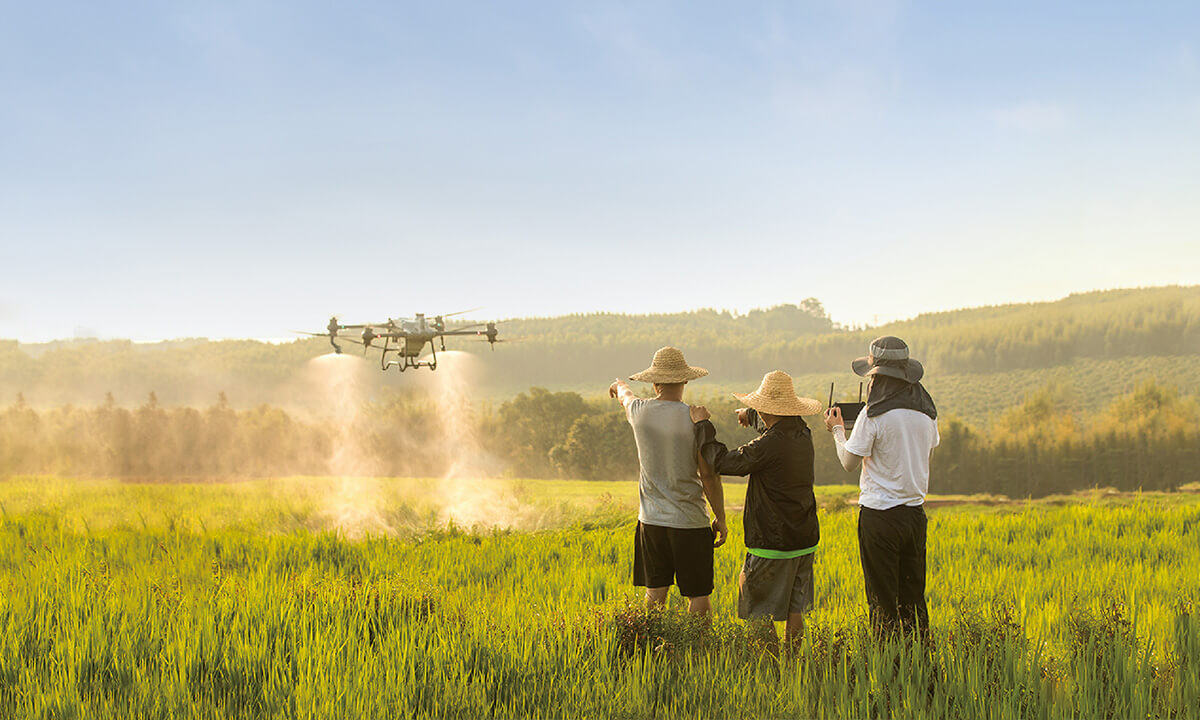

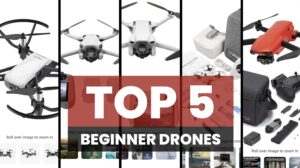

Pingback: The Shocking Truth: How One Drone Accident Almost Shut Down a Major UK Airport — Are We on the Verge of a Catastrophe? - Drone Gigs